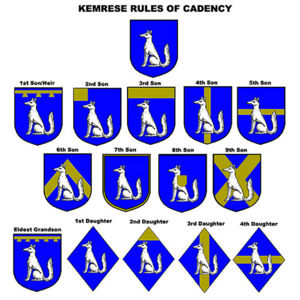Kemrese Cadency
Kemrese Cadency is a set of traditions, more-or-less established during the XVIIIth Century, to indicate specific places in birth order for those entitled to Coats of Arms in Kemrese Heraldry. In general such cadencies are not subject to inheritance. Grandchildren of those entitled to Coats of Arms must have their own arms, albeit often with some thematic continuation.
Eldest Sons/Heirs
The eldest son and/or heir uses a golden (aka Or) label with three points during the life of the current holder of the COA. The exception to this is when the heir is either of the same generation as the current holder (i.e. a brother) or two generations forward of the holder (i.e. a grandchild). In the latter case, the label has five points.
If, however, the background (or Field) is already gold, then the label should be silver (or Argent). This is the general rule followed whenever the field is the same color as the cadence.
Younger Sons
The marks of cadency for sons are established for the eight following the eldest son/heir. It should be noted that after historically the cadencies for eighth and ninth sons are very rarely used, and perhaps for that reason are the most subject to variation:
- Second Son A golden square (or Canton) is added in the upper right (or Dexter) of the field. Should the original arms already contain a canton, then said canton receives a golden bordure. If it already has such a border, it gains an exterior border.
- Third Son A golden horizontal line (or Chief). Sometimes this will contain a personal badge, such a rose or cross or anchor.
- Fourth Son A golden vertical line (or Pale) upon the field.
- Fifth Son A golden horizontal line (or Fess) upon the field.
- Sixth Son A golden chevron is added to the field.
- Seventh Son A bordure of gold. If said arms already contain a bordure, the new one is interior to the original. Should the original bordure also be gold, the new is silver.
- Eighth Son The original "rule" here was that the primary charge of the arms be doubled. However, this was not always practical, particularly for quartered arms or arms consisting of geometric patterns. Generally, when doubling the charge is impossible, the rule is to add some kind of (hopefully simple) personal badge on a small shield (or Inescutcheon) in the center of the field (or the Fess Point). In a few cases this rule has been ignored altogether and the eighth son has received the cadency of the ninth. However, in the XVIIIth century heralds essentially decided that the "tradition" was simply a matter of someone copying the rare instance where there was an eighth son who survived. Rather than maintaining this problematical tradition the rule (such as it was) became to use the Inescutcheon.
- Ninth Son A golden cross (or Saltire) upon the field.
Daughters
Given the fact that Kemr uses Salic Law, less attention has been paid to female cadency. Rather than a shield, women use a diamond shape (or Lozenge). The cadency of daughters has only been worked out to the fourth daughter.
- First daughter Simply bears the arms upon a Lozenge.
- Second daughter A Chief Or upon the field.
- Third daughter A Pale Or upon the field.
- Fourth daughter A Fess Or upon the field.
Traditionally, later daughters would receive some individual forms of cadency, although the tendency to echo those of the sons was very strong.
